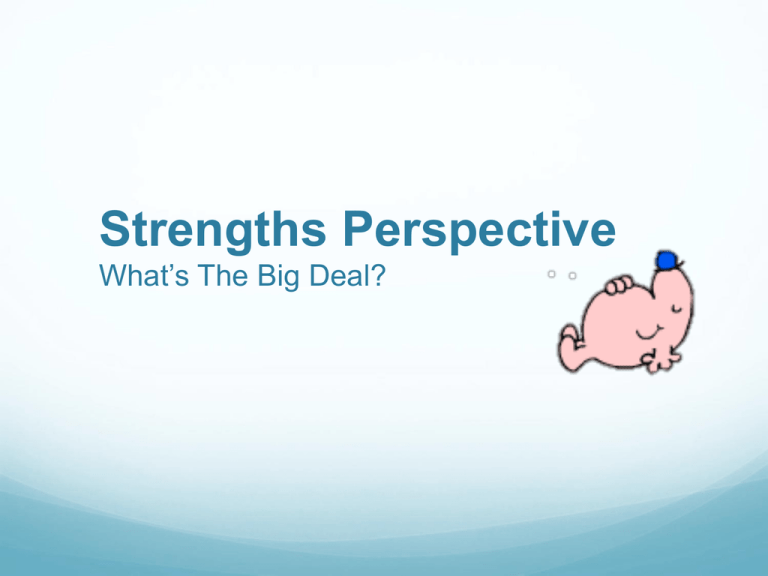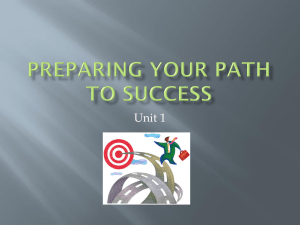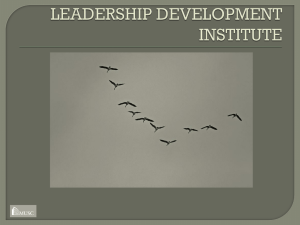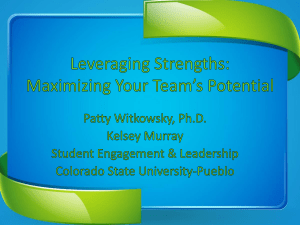Using Strengths Perspective in Human Service
advertisement

Strengths Perspective What’s The Big Deal? Introduction Thank You Introduction Challenge for SWP in SG A Applicability Limitations B Introduction Does it always help? Is it practical? Is it not fake if I just cannot see the positives and strengths in the situation? What if someone has no strengths at all? Do I have to be a optimist? What if my agency context challenges the SP? Introduction Challenge for SWP in SG A Applicability Limitations B Introduction Communities Principles In Practice Saleebey’s Principles Every Individual, Group, Family and Community Has Strengths Trauma and Abuse, Illness and Struggle May Be Injurious, but They May also Be Sources of Challenge and Opportunity Assume That You Do Not Know the Upper Limits of the Capacity to Grow and Change and Take Individual, Group, and Community Aspirations Seriously We Best Serve Clients by Collaborating with Them Every Environment is Full of Resources Caring, Caretaking and Context Communities SP in Management & Agency Culture SP in Supervision SP with Clients Introduction Using the Principles reflect on the following How have you seen or experienced the SP operationalized in your practice/context? If not yet operationalized, how do you see it being done. Your ideas, suggestions, thoughts, dreams… Flourishing of Strengths Strengths Perspective Theory Philosophical Inventory Do you believe that positive change is possible with the most “difficult” and “challenging” people? What do you do to promote change? How do you work with others with the belief that they cannot change? If you do not believe that the people with whom you work can change, what keeps you in the field? Why the struggle? Consequences to challenging current paradigm Exigencies of getting work done Sense of Powerlessness (Learned Helplessness) What is it? The Strengths Perspective offers a set of guiding principles that shape the lens for viewing human behaviour in a very different way. The fundamental premise is that individuals will do better in the long run when they are helped to identify, recognize and use the strengths and resources in themselves and their environment. What is it? The Strengths Model “allows us to see possibilities rather than problems, options rather than constraints, wellness rather than sickness. And after being seen, achievement can occur”. (pg 34, Rapp & Goscha, 2006) Conditions for Change Feeling safe and confident A sense of ownership and responsibility Validation of people’s feelings and experience Recognition of and emphasis on people’s strengths and capabilities A sense of hope Sufficient motivation Openness to other truths, meanings and possibilities What are strengths? Almost anything can be considered a strength under certain circumstances Dennis Saleebey, 2006. What are strengths? What people have learned about themselves and others Personal qualities, traits and virtues What people know about the world around them Talents people have Cultural and personal stories and lore Pride The Community Spirituality STheory What is it? The Strengths Perspective is about HOPE Strengths Perspective Practice Tool 1 Strength Cards Tool 2 5 Column Approach Tool 3 Ecomaps with Strengths Tool 4 Own Attitude Tool 5 Life’s Impossible Challenges Strengths Perspective Practice Reflections SP in Professional & Agency Setting What Prevents? What Promotes? Introduction malgudi@me.com Challenge for SWP in SG A Applicability B Limitations Contribute to the literature of SP





